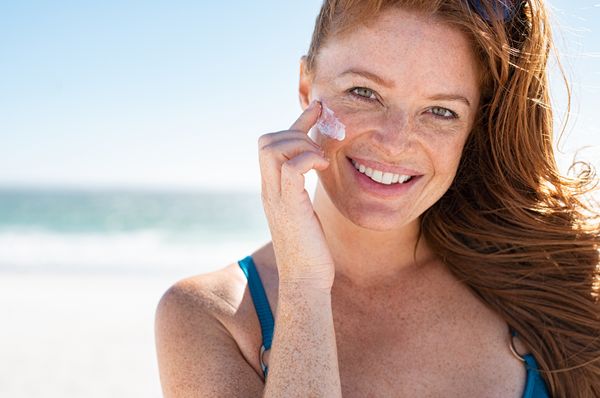By Adewole S. Adamson, University of Texas at Austin
Melanoma is a potentially deadly form of skin cancer that effects people of every racial and ethnic group. The risk factor most closely linked to developing melanoma is exposure to ultraviolet, or UV, rays from the sun. In fact, sunburns have been associated with doubling one’s risk of melanoma.
Sunscreen can block UV rays and therefore reduce the risk of sunburns, which ultimately may reduce the risk of developing melanoma. Thus, the promotion of sunscreen as an effective melanoma prevention strategy is a reasonable public health message.
But while this may be true for light-skinned people, such as individuals of European descent, this is not the case for darker-skinned people, such as individuals of African or Asian descent.
The public health messages promoted by many clinicians and public health groups regarding sunscreen recommendations for dark-skinned people is not supported by the available evidence. Media messaging exacerbates the problem with headline after headline warning that Black people can also develop melanoma and that Black people are not immune.
To be sure, they can get melanoma, but the risk is very low. In the same way, men can develop breast cancer, however, we do not promote mammography as a strategy to fight breast cancer in men.
This message is important to me as a Black board-certified dermatologist and health services researcher at Dell Medical School at the University of Texas at Austin, where I am director of the pigmented lesion clinic. In this capacity I take care of patients at high risk for melanoma.
Melanoma in Black people is not associated with UV exposure
In the U.S., melanoma is 30 times more common among white people than Black people.
In Black people, melanoma usually develops in parts of the body that are not exposed to the sun, such as the palms of the hands and soles of the feet. These cancers are called “acral melanomas,” and sunscreen will do nothing to reduce the risk of these cancers.
When was the last time you had a sunburn on the palms or soles? Even among white people, there is no relationship between sun exposure and the risk of acral melanomas. Famously, Bob Marley died from an acral melanoma on his big toe, but sunscreen would not have helped.
The rare form of skin cancer that killed Bob Marley is thought to be caused by an injury or trauma.
Last year my research group conducted a systematic review in which we analyzed all of the published medical literature related to UV exposure and melanoma in people of color. This includes those of African, Asian, Pacific Islander, Indigenous and Hispanic descent. Of the 13 studies that met our criteria for inclusion, 11 showed no association between UV exposure and melanoma.
Among the two studies that showed an association, one study showed a positive association between melanoma and UV exposure in Black men. But that same study also examined UV exposure and melanoma in other groups, including Black women, white men and women and Hispanic men and women. In these other groups the researchers found no association between UV exposure and melanoma. This is a surprising result, given that white people are the group in which the association between UV exposure and melanoma has been consistently demonstrated, calling into question the validity of the study results.
The other study showing an association between UV and melanoma was among Hispanic men in Chile based on latitude within the country. A major caveat to this study is that the city with the highest number of melanomas is also home to a large population of Chileans of Croatian descent, who would not be considered people of color.
Unfortunately, none of these studies measured melanin concentrations of individuals, so it is not possible to know whether theoretically lighter-skinned people of color may be at risk for UV-associated melanoma. However, even in light-skinned East Asian individuals, there is no evidence that UV exposure is linked to melanoma.
The bottom line is that the link between UV exposure and melanoma in people of color has been studied many times over and has yielded little to no evidence of a connection.
Racial disparities in melanoma outcomes are not related to UV exposure
Many dermatologists often point out that Black patients tend to show up to the doctor with later-stage melanoma, which is true. However, this is an issue of access and awareness and has nothing to do with sunscreen application or protection from the sun. Black people should be aware of growths on their skin and seek medical attention if they have any changing, bleeding, painful or otherwise concerning spots, particularly on the hands and feet.
However, the notion that regular application of daily sunscreen will reduce an already extremely rare occurrence is nonsensical.
UV radiation does affect dark skin and can cause DNA damage; however, the damage is seven to eight times lower than the damage done to white skin, given the natural sun-protective effect of increased melanin in darker skin.
To be clear, using regular sunscreen may help with reducing other effects of the sun’s rays such as sunburns, wrinkling, photoaging and freckling, which are all positive. But for the average Black person, sunscreen is unlikely to reduce their low risk of melanoma any further.
If sunscreen were important in the prevention of melanoma in dark-skinned patients, then why have we never heard of an epidemic of melanoma in sub-Saharan Africa, a region with intense sun, a lot of Black people and little sunscreen?
In certain subpopulations of Black people, such as those with disorders causing sun sensitivity, or patients with albinism – a condition in which people produce little or no melanin – or those with suppressed immune systems, sunscreen use may reduce risk of melanoma. But if you don’t fall into one of these categories, any meaningful risk reduction from the application of sunscreen is unlikely.
One-size-fits-all public health messaging misses the mark
Many dermatology and skin cancer-focused organizations – a few of which I belong to – promote the public health message of sunscreen use to reduce melanoma risk among Black patients. However, this message is not supported by evidence. There exists no study that demonstrates sunscreen reduces skin cancer risk in Black people. Period.
This issue of regular sunscreen use in Black people was made even more pressing after the release of two recent studies on sunscreen absorption in the Journal of the American Medical Association. This study showed that significant amounts of certain chemical sunscreen ingredients can get in the blood when used at maximal conditions, with unknown impacts on human health.
To me, the most shocking part of the studies were that most of the participants were Black, the group least likely to derive any meaningful associated health benefits from sunscreen, while being exposed to potentially harmful levels of chemicals.
As dermatologists and public health advocates, we can improve how we educate patients and the public about melanoma prevention without promoting public health messages that are grounded in fear and lack evidence. Black people should be informed that they are at risk of developing melanoma, but that risk is low.
Any dark-skinned person who develops a new, changing or symptomatic mole should see a doctor, particularly if the mole is on the palms or soles. We don’t know what the risk factors are for melanoma in Black or dark-skinned people, but they certainly are not UV rays.
This is an updated version of a piece that was published on May 14, 2019.![]()
Adewole S. Adamson, Assistant Professor of Internal Medicine (Division of Dermatology), University of Texas at Austin
This article is republished from The Conversation under a Creative Commons license. Read the original article.







